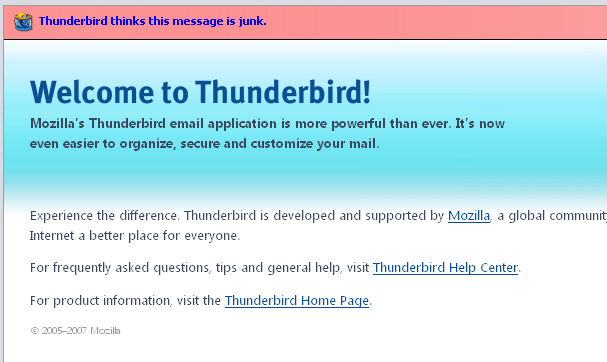I found this beautiful and simple example of a revealing error featured in the fantastic (and very funny) Error’d series on Worse Than Failure:

My guess is that before most users start the Mozilla Thunderbird email client for the first time, they don’t know that the software has a spam detection feature. That said, when the welcome message that automatically shows up in the inbox of every new Thunderbird user is prefixed by a notice that the message in question might be “junk,”, users’ ignorance on the matter will quickly be put to rest!
Of course, much more than the simple existence of the spam-flagging system is revealed by this error. With a little reflection, we can infer some of the criteria that Thunderbird must be using to sort spam or junk from legitimate email. Most mail systems, including Thunderbird use a variety of methods which, in aggregate, are used to determine the likelihood of a message being spam. Thunderbird’s welcome message is not addressed directly to the user in question and it makes extensive use of rich-text HTML and images — both common characteristics to spam.
Central to most modern spam-checkers is a statistical analysis of words used in the content of the email. Since spammers are trying to communicate a message, a prevalence of certain words and an absence of others is usually sufficient to sort out the junk. Sure enough, the Thunderbird welcome message is written using rather impersonal and marketing-speak terms that would be less likely in personal email (e.g., offering “product information”).
From the perspective of the Thunderbird developers, the flagging of this message as spam seems to be in error. From the perspective of the user though, it is not quite as clear. The Thunderbird message is both unsolicited and commercial in nature — essentially the definition of spam. In the “looks like a duck” sense, it uses words that make it “read” like spam.
While this simple error can teach Thunderbird users about the existence and the nature of their spam-checker, it might also teach the folks responsible for the Thunderbird welcome message something about the way the their messages might seem to their users.